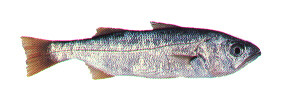- Queenfish
Taxobox
name = Queenfish

image_width = 250px
image_caption =
regnum =Animal ia
phylum = Chordata
classis =Actinopterygii
ordo =Perciformes
familia =Sciaenidae
genus = "Seriphus"
genus_authority = Ayres, 1860
species = "S. politus"
binomial = "Seriphus politus"
binomial_authority = Ayres, 1860Queenfish ("Seriphus politus") are a species of
croaker occurring fromUncle Sam Bank ,Baja California , toYaquina Bay ,Oregon ; they are the only species in the genus "Seriphus". They are common during summer in shallow water aroundpier pilings on sandy bottoms. They are found at depths up to 180 feet; however, occur more often from 4 to 27 feet. Queenfish are common insouthern California , but are rare north ofMonterey, California .Description
The body of the queenfish is elongate and moderately compressed; the largest recorded specimen was 12 inches. The head is compressed with the upper profile depressed over the eyes. The mouth is large. The color is bluish above becoming silvery below and the fins are yellowish. Queenfish can be distinguished from other croakers by their large mouth, the base of the second dorsal and
anal fin s being about equal, and the wide space between the two dorsal fins.Queenfish feed on small, free swimming
crustacean s, smallcrab s, and fishes. Adult queenfish spawn in the summer. The eggs are free floating. Tiny young queenfish, less than 1 inch long, appear in late summer and fall; first at depths of 20 to 30 feet, gradually moving shoreward until they enter thesurf zone when 1 to 3 inches long.Fishing information
Queenfish may be caught using cut shrimp or squid as bait. They are one of the most commonly caught fish by anglers from California piers.
References
*Much of this article is copied from [http://www.dfg.ca.gov/mrd/mspcont3.html#top California Marine Sportfish] by the California Department of Fish and Game, Marine Region; a public domain resource. [http://www.dfg.ca.gov/html/conditions.html#ownership]
Wikimedia Foundation. 2010.
